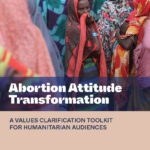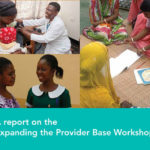In order to narrow the gap between the promise and realization of African women’s right to reproductive health care, the African Commission on Human and Peoples’ Rights adopted General Comment No. 2 last year, releasing it online earlier this month. The document was drafted under the guidance of Commissioner Soyata Maiga, Special Rapporteur on the Rights of Women in Africa, with technical support from the Ipas Africa Alliance and input from numerous reproductive rights and legal experts throughout the region.
Despite liberalization of the Nepal abortion law, young women continue to experience barriers to safe abortion services. This study evaluated differences in reproductive knowledge and attitudes by marital status. Participants were surveyed on demographics, romantic experiences, media habits, reproductive information, and abortion knowledge and attitudes. Only 45% responded that they knew that abortion was legal, and fewer ever-married women were aware of abortion legality. Never-married women expected more negative responses from having an abortion than ever-married women. Findings highlight the need for providing sexual and reproductive health care information and services to young women regardless of marital status.
The primary study aim was to describe patient satisfaction regarding abortion experiences in urban academic family medicine centers (FMCs). We conducted a cross-sectional survey of 210 women obtaining a first trimester medication or aspiration abortion at four FMCs. The majority of women (93%) were very satisfied with their abortion experience in their FMC, regardless of clinical site or abortion method. Women most commonly cited positive interactions with the staff and physicians as the best part of their experience. This study demonstrates that women who receive abortion services at academic FMCs are highly satisfied with their care.
Maternal mortality in Sierra Leone is one of the highest in the world and complications from unsafe abortion are one of the leading causes. This article reports the results of a 2012 study to assess the impact and costs of treatment of abortion complications on the country’s public health system, and estimate the costs of a shift to safe, legal abortion. The study concludesdthat a shift to safe, legal abortion would dramatically reduce the current costs of PAC.
CONTEXT: Abortion is legally restricted in Malawi, and no data are available on the incidence of the procedure. METHODS: The Abortion Incidence Complications Methodology was used to estimate levels of induced abortion in Malawi in 2009. Data on provision of postabortion care were collected from 166 public, nongovernmental and private health facilities, and estimates of the likelihood that women who have abortions experience complications and seek care were obtained from 56 key informants.
This report documents findings from a recent nationwide study of the incidence of induced abortion and severity of complications of unsafe abortion in Kenya. The study was conducted in 2012 among a nationally representative sample of Levels II to VI public and private health facilities. The Abortion Incidence Complications Methodology (AICM) and the Prospective Morbidity Methodology (PMM) were used as well-established and complementary approaches to estimate abortion incidence and the severity of unsafe abortion complications in Kenya.
This paper assesses women’s awareness of the liberalization of abortion law and their knowledge of a place for obtaining abortion services in Nepal. The data are from the 2011 Nepal Demographic and Health Survey. The results are compared with data from a similar survey conducted in 2006. The results suggest the need to intensify efforts to educate women in Nepal, particularly the most disadvantaged women, about abortion law, including the conditions under which abortion is permitted, and where to access safe abortion services.
Although abortion became legal in India in 1971, many women are unaware of the law. To evaluate the effectiveness of a behavior change communication intervention to improve women’s knowledge about India’s abortion law and their perceptions about abortion, a quasi-experimental study was conducted in intervention and comparison districts in Bihar and Jharkhand.

Abortion by trained providers is a safe and common procedure, legal under at least one condition in nearly every country in the world. Yet women and girls living in humanitarian settings often cannot get this essential reproductive health service—even when it’s available to other women in a country hosting refugees.

Abortion by trained providers is a safe and common procedure, legal under at least one condition in nearly every country in the world. Yet women and girls living in humanitarian settings often cannot get this essential reproductive health service—even when it’s available to other women in a country hosting refugees.
Logically, all women receiving abortion care should also receive contraceptive information, and a method if they wish one; likewise, family planning providers should be equipped to support women who have unintended pregnancies. However, integrating family planning and abortion care is often a challenge.
Both Wubalem and Chaltu live only five kilometers from the nearest public health clinic. Under Ethiopian law, both have the right to safe, legal abortion. Yet, because of unnecessarily broad interpretation of U.S. government policy, one was denied this fundamental right.
To explore the feasibility of educating communities about gynecologic uses for misoprostol at the community level through community-based organizations in countries with restrictive abortion laws, the Public Health Institute and Ipas conducted an operations research study in 2012.
This study examined awareness of unwanted pregnancy, abortion behaviour, methods and attitudes toward specific legal indications for abortion via a school-based internet survey among 378 adolescents aged 12–21 years in three Rio de Janeiro public schools.
Despite the adoption of the Medical Termination of Pregnancy Act in 1972, access to safe abortion services remains limited in India. Awareness of the legality of abortion also remains low, leading many women to seek services outside the health system.

Abortion by trained providers is a safe and common procedure, legal under at least one condition in nearly every country in the world. Yet women and girls living in humanitarian settings often cannot get this essential reproductive health service—even when it’s available to other women in a country hosting refugees.

Abortion by trained providers is a safe and common procedure, legal under at least one condition in nearly every country in the world. Yet women and girls living in humanitarian settings often cannot get this essential reproductive health service—even when it’s available to other women in a country hosting refugees.
Sex workers’ need for safe abortion services in Uganda is greater than that of the population of women of reproductive age because of their number of sexual contacts, the inconsistent use of contraception and their increased risk of forced sex, rape or other forms of physical and sexual violence. This study sought to understand sex workers’ experiences with induced abortion services or postabortion care (PAC) at an urban clinic in Uganda. Nine in-depth interviews were conducted with sex workers. Several important programmatic considerations for safe abortion services for sex workers were identified. Most important is creating community-level interventions in which women can speak openly about abortion, creating a support network among sex workers, training peer educators, and making available a community outreach educator and community outreach workshops on abortion.

A report on the Expanding the Provider Base Workshop hosted by Ipas in 2013. The workshop brought together delegates from nine countries in Africa, Asia and North America and facilitated the sharing of resources and strategies related to expanding the role of non-physician providers in abortion-related care. It details discussion of key topics at the workshop, including the need for and evidence behind expanding cadres of CAC/PAC providers.
This publication provides an overview of the neglected sexual and reproductive health needs and rights of migrant, refugee and displaced women.

